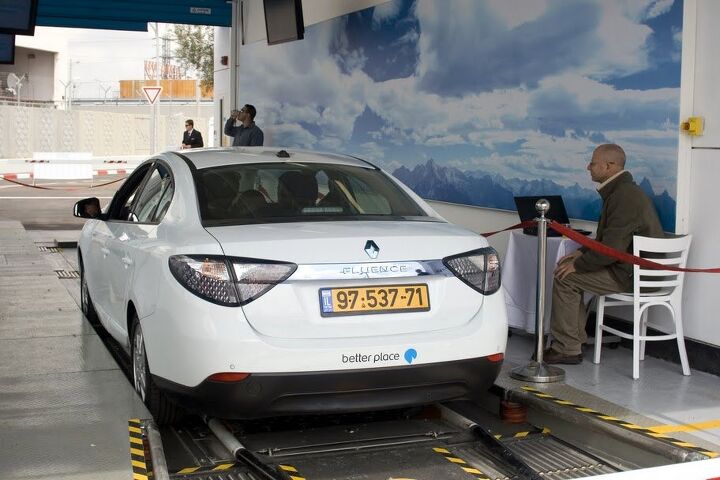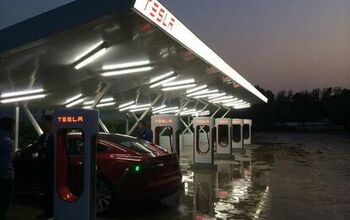Inside Israel's First Battery Swap Station
When Better Place launched their Visitor Center in Tel Aviv, the attending journalists’ fingers couldn’t keep up with all the numbers and the promises flogged by the company chiefs: tens of battery switch stations to be built, hundreds of charging stations to be deployed and a thousand cars to be sold to Israeli customers each month.
Just over a year has passed since these statements made air, and in typical Israeli fashion – most of the goals were not met. Despite promising to begin delivery of cars in the beginning of 2011, Better Place has not sold a single car over the four months that passed since New Year’s Eve. And the number of battery switch stations built in Israel was – you guessed it – exactly zero. Until now.
I couldn’t blame the residents of Kiryat Ekron – a small town located about 20 minutes south of Tel Aviv – for mistaking Better Place’s latest effort for an automatic car wash. Examined up close, Better Place’s first commercial car battery switch station still looks like a carwash for the yuppie: it’s a white, square structure with an appropriately modern rounded-rectangle tunnel attached to it, standing in the backyard of a gas station.
But before we talk about switching batteries, let’s talk about cars. Namely, let’s talk about the Renault Fluence Z.E, which Better Place sets to be its most important car in Israel. So far, Better Place has only demonstrated their solution to the public using a fleet of converted Renault Lagunas – one of which I briefly drove last year. The launch of the first Israeli battery switch station was the first opportunity for me to meet the nearly-finalized prototype of Better Place’s flagship in person.
Unsurprisingly, it’s based off the Renault Fluence – which in its turn is a bigger, four-door version of the Megané, targeted mainly at developing markets outside of Europe. While the Fluence is formally a compact car – despite being quite large for its segment – its electrified sibling errs ever further towards midsize in the automotive wardrobe, having been extended by a few inches in order to accommodate the battery somewhere underneath the rear seats. Interior dimensions seem to have remained the same, while trunk space was slightly compromised in the conversion process.
While Better Place didn’t let us drive the cars ourselves, performance figures seem to be adequate – just over 10 seconds from 0 to 60 mph and an electrically (no pun intended) governed top speed of about 90 mph – all that from an engine putting out about 90 horsepower and 167 ft-lb of torque. Interestingly, according to Better Place officials, the entire battery pack weighs just under 660 pounds, while Renault itself gives a more optimistic 550 pound weight figure.
The battery switch process itself is thoroughly unexciting, which must mean great praise for Better Place’s work in developing the concept. The driver only needs to flash his Better Place RFID card at the machine, drive into the rather narrow tunnel and find something to occupy himself with during the upcoming 3 minutes. The car slides into position, slightly lifted – then an underground robot grabs the battery, disappears – and returns with a fresh one. All of this is invisible to the technologically impaired driver, while the geekier amongst us can watch the entire process streamed live on a TV planted outside.
Better Place says that the stations are designed to be modular and compatible with several different vehicles and that 15 batteries are stocked in every station at all times. Even though that doesn’t sound like a lot, Better Place claims that the calculations they’ve made found this to be the optimal number. 8 more switch stations are in construction, and the company set 40 stations throughout the country as its initial goal, despite initially promising 70 stations by the end of 2010. According to company officials, they found that 40 stations provide a complete coverage of Israel, and that more stations may be installed in the future according to answer demand in key locations.
Shai Agassi, the company’s charismatic CEO and founder, was as optimistic and ambitious as usual. “You’re seeing the second Apple”, he announced in the press conference that followed the switch demo. This time, however, Agassi and his team were significantly less keen on throwing promises around – only committing to starting distribution to customers on Q4/2011.
Despite already announcing its pricing schemes in Denmark in the beginning of this month, Better Place refuses to reveal Israeli prices at this time. An internal Better Place memo which leaked to the Israeli press, however, sets the price of the Renault Fluence Z.E at 123,000 NIS, or about $34,500. That may sound like a lot of money for a compact car, but consider that in heavily taxed Israel, the bestselling car – the Mazda3 – is only some $800 cheaper, while lacking much of the equipment that the tax-reduced Fluence Z.E is expected to carry standard.
As fleet sales account for more than 60% of the new car market in Israel, Better Place is aiming to sign contracts with the country’s most prominent rental and lease companies in which it guarantees buyback of its vehicles after three years in service in exchange for a commitment by the companies to price the Fluence Z.E closely to internal combustion competitors.
If the Danish pricing schemes are of any indication, Better Place is expected to offer several different plans for various mileages. In Denmark, the most expensive plan – allowing for unlimited mileage –costs the user about 400 euros (or about $550) per month, while the most basic – allowing for up to 12,000 miles per year – costs from 200 ($280) to 250 ($350) euros. Considering Israel’s slightly higher gasoline prices, the appropriate plans in the Holy Land will likely cost more compared to Denmark.
And if those prices sound a bit high to you, it’s probably because they are. A very rough calculation puts one month of Denmark-priced gasoline for an average compact car travelling 12,000 annual miles very close to the price Better Place offers for that mileage, and perhaps even slightly higher. It seems that Better Place’s main lure would be the ‘unlimited’ packages. On its end, Better Place doesn’t try to refute this claim, only going as far as promising running costs “comparable or lower” to those of equivalent gasoline vehicles.
One of the most interesting points brought up in the press conference was the compatibility of Better Place’s charging points with third party cars. The company was keen to emphasize that the charging points, of which a 1,000 have already been installed in public and private parking garages, are designed according to a “standard”, which will allow non-Better Place cars to be charged using their current infrastructure. Agassi went as far as claiming that the company doesn’t view fixed-battery EVs as competition since they only target drivers travelling short distances. Agassi was also reluctant to answer journalists’ questions regarding specific models, but said that the company is in “negotiation” with several local dealers regarding possible cooperation.
As I was standing next to one of the Fluence Z.Es parked by the curb, a curious passerby interrupted my photoshoot. “Nice looking car,” he said. “What’s the engine’s displacement?” “It’s electric,” I dutifully replied. “Oh, cool”, he noted as he continued to circle the car. “So how big is the engine?”
“Our target is for people to say it’s a car”, said Agassi in his opening statement. Did they succeed in that? The answer is a resounding yes. Better Place and Renault have managed to create a car that looks, feels and refuels like your average Camry, and for that they deserve credit. Unfortunately, that’s not the toughest challenge the company has to face. The jury is still out on the viability of Better Place’s model in real life, and in an industry as conservative, the company isn’t going to have an easy time proving the skeptics wrong.
More by Tal Bronfer
Latest Car Reviews
Read moreLatest Product Reviews
Read moreRecent Comments
- ToolGuy I am slashing my food budget by 1%.
- ToolGuy TG grows skeptical about his government protecting him from bad decisions.
- Calrson Fan Jeff - Agree with what you said. I think currently an EV pick-up could work in a commercial/fleet application. As someone on this site stated, w/current tech. battery vehicles just do not scale well. EBFlex - No one wanted to hate the Cyber Truck more than me but I can't ignore all the new technology and innovative thinking that went into it. There is a lot I like about it. GM, Ford & Ram should incorporate some it's design cues into their ICE trucks.
- Michael S6 Very confusing if the move is permanent or temporary.
- Jrhurren Worked in Detroit 18 years, live 20 minutes away. Ren Cen is a gem, but a very terrible design inside. I’m surprised GM stuck it out as long as they did there.








































Comments
Join the conversation
Now we know where Government Motors will export the next 238 Volt not sold to GE.
The battery swap thing is going to fail, first off because there are no standards for battery packs between various makes and models, and no reason for manufacturers to standardize. Have you noticed how every cell phone, laptop and tablet has its own custom battery pack? Have you ever tried to share batteries between your Dewalt and your Makita drills? This isn't by accident. The manufacturers have a vested interest in keeping customers locked in to their products.
Hydrogen fuel cell vehicles are far, far more likely to one day become widely used than is this present boondoggle.